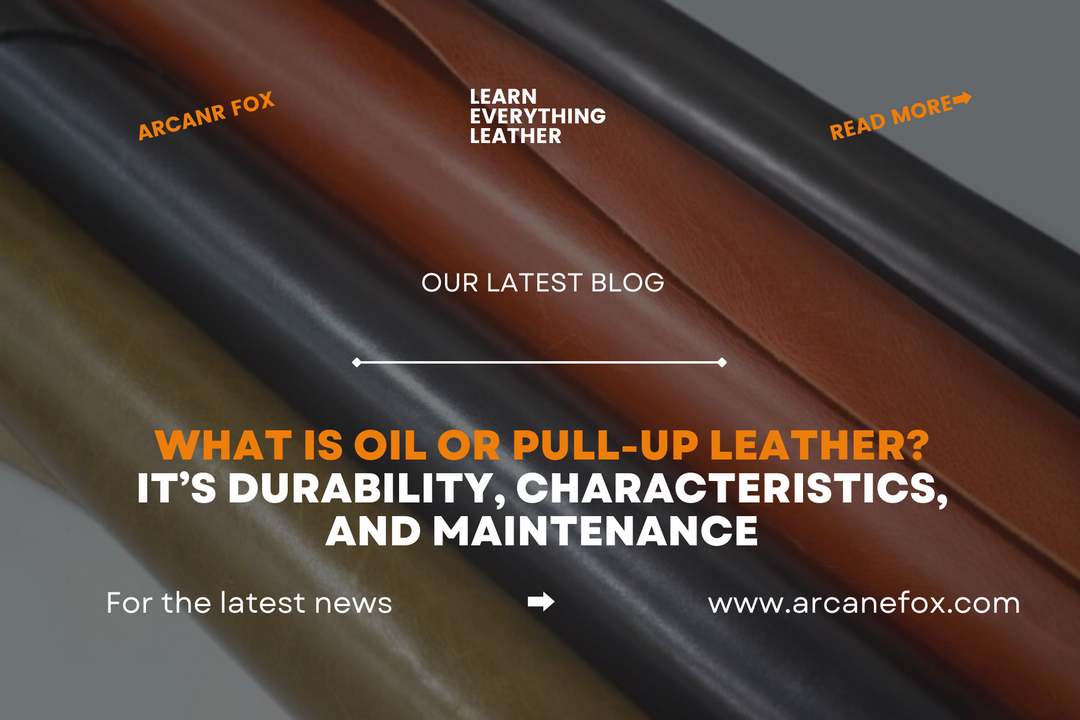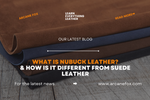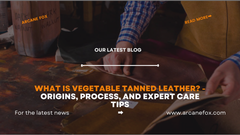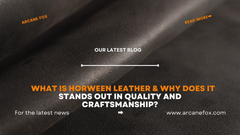What is Oil or Pull-Up Leather? It’s Durability, Characteristics, and Maintenance

What is Oil or Pull-Up Leather? It’s Durability, Characteristics, and Maintenance
The appearance of leather is one of its outstanding features. With flaws and color variations, each leather piece offers a unique tale about the hide. One of my favorite types of leather is oil leather or pull up leather because I find color changes to be the most attractive. Pull-up leather has substantially more diversity throughout the piece, and this variance only gets deeper with use.
Pull up leather is a finishing technique that gives leather a multitone appearance by adding hot oils and wax. Stretching or bending pull-up leather makes the undertones more pronounced. This offers durability and wear resistance and can be used with any type of leather. Per square foot, pull up leather ranges from $4 to $15.
What to Expect for This Blog?
We'll go into the interesting world of pull-up leather in this blog. Learn about the distinctive qualities that make it stand out, such as the multitone appearance brought on by hot oils and wax and its capacity to acquire a lovely patina over time. We'll dispel myths about its durability and go over its history, manufacturing method, and a variety of applications, including wallets and shoes. We'll also offer advice on how to take care of pull-up leather and share our personal research on how to remove scuffs and keep it looking good. You'll learn useful facts here whether you're a leather fanatic or just interested in this unique material.
1. What Is Oil Or Pull-Up Leather?

Any type of leather finished with hot oil or wax is referred to as pull up leather. Although every tannery has a unique process for making pull-up leather, the multitone result is common. A gradient exists throughout the worn areas as a result of the oils and waxes shifting as the leather is stretched or bent.
The leather becomes more durable because the effect is produced by filling the leather with a lot of hot oil or wax. Water will be resisted more forcefully than with other leathers, and scratches will fade into the leather.
2. Clearing Up Myths & Misconceptions
Pull-up leather worn patterns are sometimes mistaken for damage rather than patina. Normally, leather ages by growing darker, while pull-up leather ages by becoming lighter. The majority of marks are only superficial because the leather is packed with oil or wax; however, scratches and wear will be highlighted.
In fact, the majority of marks left on pull-up leather may be removed by simply heating the leather up by rubbing it with a towel. This aids in bringing wax or oil back to the area, blending it more seamlessly with the leather's darker areas.
3. History of Pull-Up Leather
Oils have long been used in the production of leather. Raw leather was traditionally soaked in animal fats. The fats oils would seep into the hide and coat it, making it more durable and water-resistant. The pull-up effect, however, is more than that. According to legend, Chromexcel by Horween was the first pull-up leather.
It was developed more than 100 years ago, and it overstuffs the leather using a secret mixture of oils and waxes. As a result, strong leather is produced, and the oils and waxes can be seen transferring across the surface. The pull up finishing technique is currently well-liked all over the world, with each tannery utilizing its own mixture to produce the distinctive look.
4. How Pull-Up Leather is Made?

Like most other types of leather, pull-up leather starts as an animal hide. Before tanning, the hide needs to be cleaned and trimmed. Pull up leather will be put in a pit or drum with the appropriate chemical compounds since it might be vegetable tanned or chrome tanned.
They are let to dry after tanning before the leather is colored. Both a huge vat and an airbrush can be use to apply color. The leather's final, finishing-method operation produces the pull-up effect. On the surface of the leather, waxes and/or hot oils are combine and applied.
The color of the leather will appear darker when it is covered since it is "hidden" below the polish. As a result of the leather's ability to reveal its real color when bent, this produces the pull-up effect.
5. In-depth Characteristics of Pull-Up Leather
5.1 Natural or Synthetic
Real leather, whether split, top-grain, or full-grain, is known as pull up leather. The leather's "pull up" features are essentially a result of the coating process. As a result, the hides use determine the leather quality and authenticity. Top grain, chromium-tanned leather will represent the majority of pull-up leathers.
5.2 Is Oil Leather or Pull-Up Leather Flexible?

The majority of the available hides will be fairly flexible in an effort to demonstrate the impacts of pull up leather. One of the main selling points of pull-up leather is how the color beneath is accentuate as the leather bends. In addition to being chrome tan, which results in significantly softer leather, many pull-up leathers will also be.
5.3 Is Oil Leather or Pull-Up Leather Soft?
Pull-up leather is not advertise as being soft. Although the surface is softer than soft leathers, it can only be describe as ordinary. Waxy pull-up leathers in particular may have tougher hides that take longer to break in. In order to attain its effect, pull up leather typically sacrifices suppleness.
5.4 Surface Texture
Pull-up leather's surface texture can differ. Due to the fact that the pull-up effect is produce by stuffing the leather with these substances, the two most prevalent characteristics are a waxy or oily surface. The leather may moreover already have a texture that won't be conceal by the additional wax or oil. However, pull up effects in additional textured pull up leather might only be mild.
5.5 Is Oil Leather or Pull-Up Leather Durable?

Pull-up leather becomes incredibly durable thanks to the additional hot oils and/or waxes packed into the surface. In addition to adding character by producing the pull-up appearance, scratches can be easily erase by rubbing. Additionally, the additional waxes and/or oils assist keep the leather from becoming wet. Pull-up leather is a preferred material for boots and other high-wear items because of these qualities.
5.6 Is Oil Leather or Pull-Up Leather Waterproof?
Pull up leather is water resistant, though it isn't completely waterproof, thanks to the hot oils and/or waxes stuffed into the surface of the leather, which act as a barrier, repelling and preventing water from entering the leather.
5.7 What is the Cost of Pull-Up Leather?
A common finishing technique that enables the leather to be taken over at various pricing points is pull-up type leather. Pull-up leather can be sold for as little as $4 per square foot at the low end. The tanning process improves as the quality does. The priciest pull-up leathers are those that have been vegetable tan; they can cost up to $15 per square foot.
6. Pros of Pull Up Leather
Pull up leather is a popular option for producers for a variety of factors. Its visual appeal is its first draw. It is one of the few types of leather where the patina brings out the beauty of the leather. Each and every piece that uses pull-up leather gains so much character from the lightning impact that usage creates.
Along with providing toughness and water resistance, the hot oils and/or waxes packed into the surface of the leather also reduce the amount of maintenance needed for the leather. In summary, pull up leather is a gorgeous variety of leather that is low maintenance, durable, and only gets prettier with age.
7. Cons of Pull Up Leather
Pull up leather has very few cons because the majority of its qualities are appealing. The pull effect, though, may make it harder for some people to enjoy a project. Pull-up leather scratches more easily and loses its shine more rapidly than other types of leather, which is a problem for people who want to keep their leather looking brand new.
For crafters, the oily or waxy surface can build up on needles or thread or bleed onto other materials. The thread could get dirty as a result, necessitating several stops to replace it.
8. Some Pull Up Leather Products

9. Our Personal Research on Pull Up Leather
The patina that develops from using the leather over time is an essential component of pull-up leather. However, leather that is pull up scratches easily. While some scratches are acceptable as part of the patina, others might be ugly. I looked into and put to the test numerous methods for eradicating scratches and restoring color uniformity.
9.1 Rubbing the Leather
Scratches are most frequently repair by rubbing the leather. I experimented with a rag and my fingertip. Scratches could be remove with little apparent difference, however rubbing with a cloth also produced a slight sheen. Scratches on the surface were not a problem, but as they progressed in depth, they became harder to conceal and would only slightly darken.
9.2 Rubbing the Leather With Leather Balm
When practical, waxes and oils found in leather balm have a tendency to make leather darker. In this test, I tried to hide comparable scratches by applying leather balm to a cloth instead. The balm appeared to fill and darken the lighter regions, which was a fantastic performance.
Deep scratches that had not yet reach the leather's color were also skillfully fill. One thing to take note of is that the area where the leather balm was apply was a little bit darker than the region around it. To maintain a consistent color using this procedure, the entire leather surface may need to be cover.
9.3 Using a Heat Gun
One common technique I have always been dying to attempt is warming the waxes and oils in the leather before rubbing it with a heat gun or hair dryer. I did this by directing a heat pistol at the scratches while it was on the lowest setting.
The scratches vanished right away with the heat, and when I touched the surface, they were completely gone. If serious scratches didn't remove enough of the leather's color, they may be cover.
10. Oil Leather or Pull Up Leather Care and Maintenance
10.1 How to Clean a Pull Up Leather?

Pull up leather may require a little extra care when cleaning because it tends to collect more dust than other leathers. The surface should be cleane with a delicate horse hair brush, but any stuck-on debris can easily be remove with a damp rag. After dusting, thoroughly clean the surface with a clean rag and saddle soap. When using saddle soap, it is preferable to condition the leather first to stop it from drying out.
10.2 How to Condition Pull-Up Leather?
Although pull up leather needs more dusting than regular leather products, it won't require as much conditioning. Unless the leather gets wet or after using leather soap, once or twice a year is more than enough. Use a clean cloth and a small bit of leather conditioner to condition the leather. Before using more conditioner, rub it over the leather surface and let it air dry fully.
10.3 How to Store Pull Up Leather?
It's crucial to keep pull-up leather out of the sun and heat when storing it. Both may result in the leather drying out after extended exposure. Any pull up leather should ideally be kept in a dust bag. When pulling out the leather for usage, keeping the dust and debris contained can be helpful because the leather draws both of these things.
11. Conclusion
Deeper scratches took more work to remove, although all tested methods were successful at doing so for surface-level scratches. A leather balm can be use in those circumstances, however it might make the region darker. The heat gun was the most effective since it repaired deep scratches more quickly and without darkening the region. It is significant to note that none of the tested methods can restore the color of leather that has been scratch.
Learn more about leather here Leather 101 - The Ultimate Guide to Different Types of Leather
Related Topics
What is Aniline Leather? Types of Aniline, Characteristics, And More
What is Semi-Aniline Leather? History, Characteristics, And More
What is Burnished Leather? & Why Should It’s Be Your Top Choice
What is Antique Leather? & Why it is So Popular
What is Bicast Leather? Myths, Facts, and Benefits
What is Embossed Leather? & How to Use This Process
What is Embroidery Leather? & What to Look for In Leather Embroidery?
What is Faux Leather? It’s Quality & Durability Against Other Leather!
What is Nappa Leather? Quality, Characteristics, and Maintenance
What is Nubuck Leather? & How is it Different From Suede Leather
What is Patent Leather? & How to Maintain It’s Quality and Shining
What is Pigmented Leather? How is it Made, It's uses and characteristics





